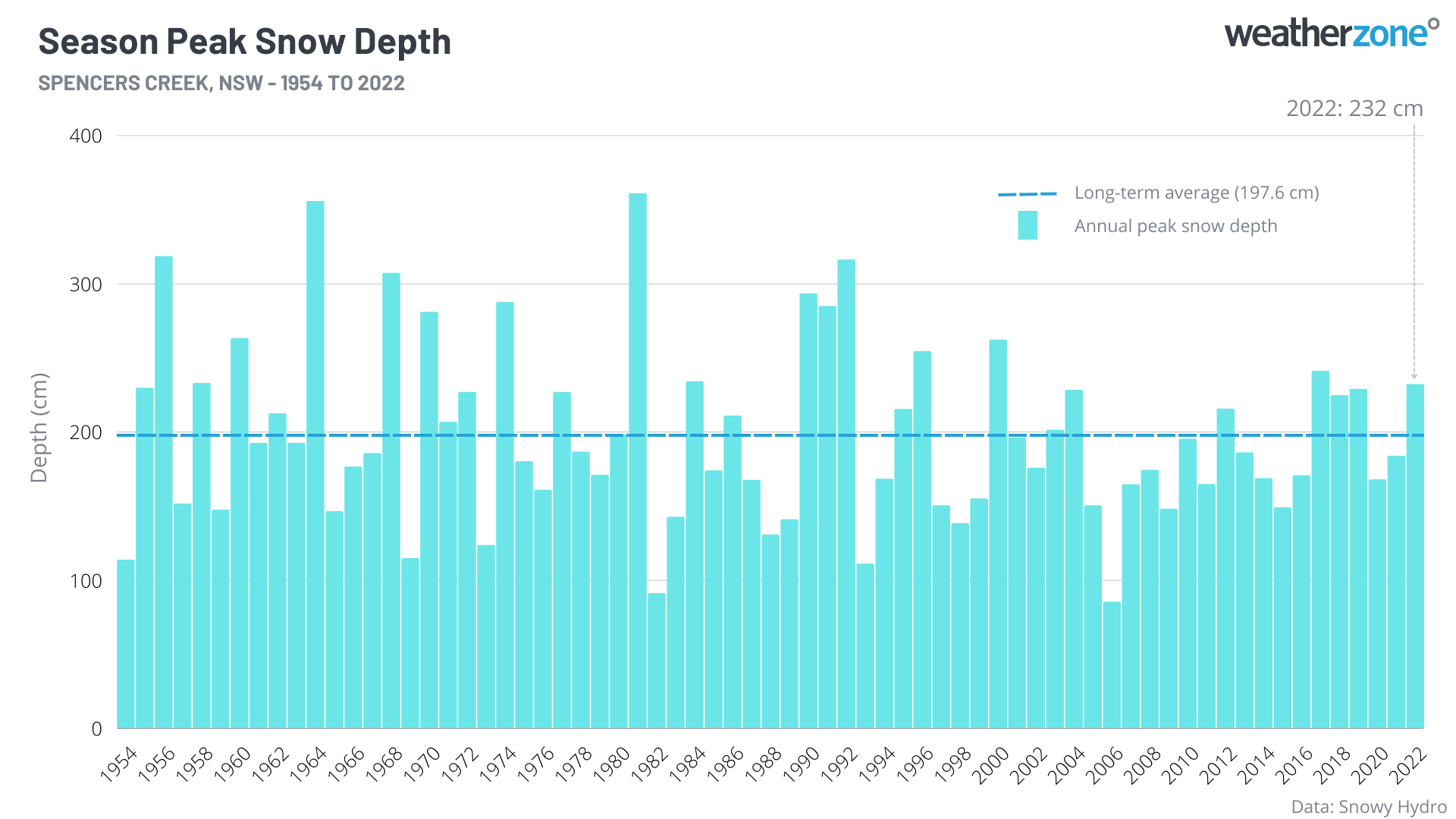2022 snow season wrap: good up high, bad down low
High elevations of Australia's mainland snow country saw the third-best peak snow depth of the 21st century, but at lower elevations it was a dismal year, while Tasmania barely saw any consistent snow cover at all.
Let's start with the good news, which is well illustrated in the graph below which shows the official Snowy Hydro measurements at Spencers Creek (about halfway between the NSW ski resorts of Perisher and Thredbo) over the last 68 years.

As you can see, the 2022 peak depth of 232 cm was about 17% above the long term peak-depth average of 197.6 cm.
For a few weeks, it looked like the 204.5 cm recorded on August 24 would be the season peak, before a mid-September snowstorm briefly but significantly bolstered the snowpack.
With so much snow up high, on the back of a very early snowfall in early June, Australia's higher ski resorts enjoyed a bumper season with huge crowds that only thinned out in late spring, as you can see in this reporter's tweet below.
Hello from the Ridge quad chairlift queue at @PerisherResort in springtime. I like it better than midwinter! pic.twitter.com/jBxuHvRgtJ
— Anthony Sharwood â„ï¸ (@antsharwood) September 22, 2022
But as mentioned at the top of this story, it was a different situation lower down.
Thredbo is both Australia's highest and lowest mainland ski resort (1370m to 2037m, which is why its runs are so much longer than anywhere else). The village barely saw any snow this year with lower runs depending almost entirely on snowmaking. Up high, the full bounty of that two metre-plus cover was on offer.
Further south at Mt Baw Baw in Victoria, which is the mainland ski resort with the lowest top elevation (of just 1564 m), it was a patchy sort of season with only two or three of the seven lifts spinning for most of winter.
So in summary: the big snowstorms are still hitting the Aussie mainland, but the snow appears to be melting much quicker at lower elevations, likely due to climate change influences.
As the BoM noted in its winter 2022 seasonal summary, Australia's national mean temperature for winter was 0.36 °C above the 1961–1990 average.
The decline in snow at lower altitudes is well captured in this pair of graphs, which again use Snowy Hydro data, but this time at both Spencers Creek and the much lower station of Three Mile Dam, at 1460m in Kosciuszko National Park.

The two graphs compare the 2022 and 1972 seasons, which were 50 years apart and are noteworthy because the peak depths at Spencers Creek were almost identical.
The top graph shows two fairly similar lines. The second graph reveals a different story.
It shows how snow declined rapidly this year at the lower elevation of Three Mile Dam after the big early June fall, to the point where there was almost no cover throughout the peak month of August (the dark blue line).
By contrast, in 1972 the snow stuck around for a good three months at the lower elevation (the light blue line).
As for Tasmania in 2022, forget it. This year was almost a total write-off. While occasional snowfalls dusted the Apple Isle to quite low elevations at times, there was no significant accumulation that allowed Tassie's two tiny resorts to open for more than a few consecutive days.
Meanwhile, six ski resorts still have their lifts spinning this weekend, with the three NSW resorts staying open till Monday as it's a public holiday in that state.
Please click the highlighted links to the snow reports at Mt Buller, Falls Creek, Mt Hotham, Thredbo, Perisher, and Charlotte Pass for more info, and we'll be back talking snow in 2023!
Until the close of the 2022 season, you can also keep checking the Weatherzone snow page for the latest cams, forecasts and other info.
